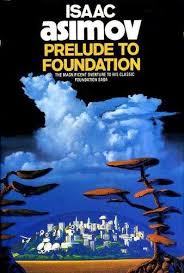-spoilers for the entire Foundation universe-

Publisher: Guild Publishing
Genre: Social SF
Series: Foundation Prequels (#1)
Pages: 461
Publication Date: 1988
Verdict: 5/5
Hari Seldon has come to Trantor to present his latest paper: a mathematical treatise on his bold new theory of psychohistory. But while Seldon sees his paper as little more than a curiosity, there are those who see far more potential in it. Even some who are willing to kill for control of psychohistory . . .
Hari Seldon. Trantor. Psychohistory. With these three names, we at last reach the Foundation series itself. Nemesis aside, the prequel duology, of which this is the first, were Asimov’s final addition to his sprawling future history. They have a lot of heavy lifting to do, tying together the various threads of the Foundation universe while also telling a story in their own right. Thankfully, by this stage in his career, Asimov was more than up to the task, and this is some of his best work.
Prelude to Foundation is, in many ways, exactly what you’d expect given the title. It’s the story of a young Hari Seldon and his first steps on the Galactic stage, coupled with the development of his theory of psychohistory. For the late crowd, psychohistory is the study of humanity with a view to predicting the fate of civilisation. As high-concept SF goes, it doesn’t come much higher than that. Now, psychohistory is essentiallyu unworkable in reality. You only need to look at various real-world political analysis and predictions to see that. None of this make sthe book any less mind-bending, and in fact these difficultuies are ones that Seldon faces from the outset. As the novel opens, even Seldon himself does not believe he has a workable theory. Were it not for the involvement of certain mind-altering robots, psychohistory would have no chance at all.
That’s right. Mind-bending robots. Though he is disguised for much of the novel, R. Daneel Olivaw is back, having inherited R. Giskard’s telepathic abilities. As he works in the shadows to protect humanity under the Zeroth laws of robotics, his role in the novel is largely to send Seldon to new places. More a plot device than a character in his own right, it’s nevertheless good to have him back.
As it happens, a lot of Prelude to Foundation is focused on uncovering the past. Trekking through the various regions of trnator, Seldon finds reference to robots, Earth, Aurora, Daneel and Elijah. Seeing how these iconic characters have become myth is utterly fascinating, and of course only natural for an Empire which claims to have stood for over ten thousand years. Obviously the fixed-up nature of the series leads to a few inconsistencies, but in the context it’s easy enough to view these as corruptions of the historical record. This is all deliberate, I suspect, as much is made of the way civilsiations twist history to better suit their own purposes.
Between Hari Seldon and Dors Venabili, this book contains some of Asimov’s best character work. While their relationship isn’t always convincing and has certainly dated just as much as the frequent use of microfilm on Trantor, they remain compelling characters to follow through the underbelly of the city-world. I’m tempted to say that, between strong characters and a tense plot, this is one of the best places to start with Asimov, though a prior knowledge of the series would certainly enrich one’s reading.
Prelude to Foundation is a great novel by itself, but it’s also an excellent set-up for the greater series that is still to come.

